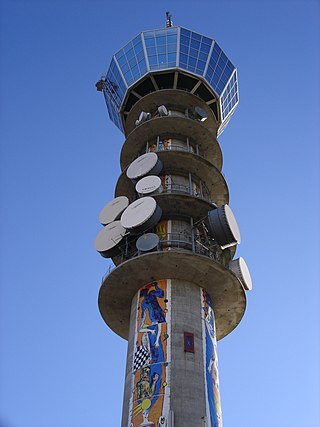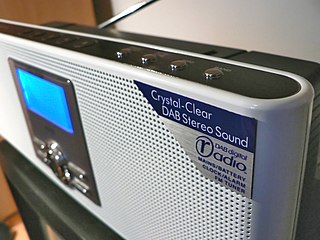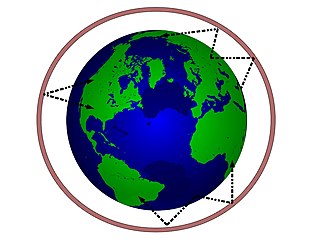The services of communication in Jersey comprise Internet, telephone, broadcasting and postal services, which allow islanders to contact people and receive information.

Shortwave radio is radio transmission using radio frequencies in the shortwave bands (SW). There is no official definition of the band range, but it always includes all of the high frequency band (HF), which extends from 3 to 30 MHz ; above the medium frequency band (MF), to the bottom of the VHF band.

Very high frequency (VHF) is the ITU designation for the range of radio frequency electromagnetic waves from 30 to 300 megahertz (MHz), with corresponding wavelengths of ten meters to one meter. Frequencies immediately below VHF are denoted high frequency (HF), and the next higher frequencies are known as ultra high frequency (UHF).

Medium wave (MW) is a part of the medium frequency (MF) radio band used mainly for AM radio broadcasting. The spectrum provides about 120 channels with more limited sound quality than FM stations on the FM broadcast band. During the daytime, reception is usually limited to more local stations, though this is dependent on the signal conditions and quality of radio receiver used. Improved signal propagation at night allows the reception of much longer distance signals. This can cause increased interference because on most channels multiple transmitters operate simultaneously worldwide. In addition, amplitude modulation (AM) is often more prone to interference by various electronic devices, especially power supplies and computers. Strong transmitters cover larger areas than on the FM broadcast band but require more energy and longer antennas. Digital modes are possible but have not reached momentum yet.

Ultra high frequency (UHF) is the ITU designation for radio frequencies in the range between 300 megahertz (MHz) and 3 gigahertz (GHz), also known as the decimetre band as the wavelengths range from one meter to one tenth of a meter. Radio waves with frequencies above the UHF band fall into the super-high frequency (SHF) or microwave frequency range. Lower frequency signals fall into the VHF or lower bands. UHF radio waves propagate mainly by line of sight; they are blocked by hills and large buildings although the transmission through building walls is strong enough for indoor reception. They are used for television broadcasting, cell phones, satellite communication including GPS, personal radio services including Wi-Fi and Bluetooth, walkie-talkies, cordless phones, satellite phones, and numerous other applications.

Radio broadcasting is the broadcasting of audio (sound), sometimes with related metadata, by radio waves to radio receivers belonging to a public audience. In terrestrial radio broadcasting the radio waves are broadcast by a land-based radio station, while in satellite radio the radio waves are broadcast by a satellite in Earth orbit. To receive the content the listener must have a broadcast radio receiver (radio). Stations are often affiliated with a radio network that provides content in a common radio format, either in broadcast syndication or simulcast, or both. The encoding of a radio broadcast depends on whether it uses an analog or digital signal. Analog radio broadcasts use one of two types of radio wave modulation: amplitude modulation for AM radio, or frequency modulation for FM radio. Newer, digital radio stations transmit in several different digital audio standards, such as DAB, HD radio, or DRM.

Digital radio is the use of digital technology to transmit or receive across the radio spectrum. Digital transmission by radio waves includes digital broadcasting, and especially digital audio radio services.

In radio communication, skywave or skip refers to the propagation of radio waves reflected or refracted back toward Earth from the ionosphere, an electrically charged layer of the upper atmosphere. Since it is not limited by the curvature of the Earth, skywave propagation can be used to communicate beyond the horizon, at intercontinental distances. It is mostly used in the shortwave frequency bands.

BBC Radio Jersey is the BBC's local radio station serving the Bailiwick of Jersey.
The Breeze is a New Zealand radio station playing an adult contemporary music format owned by MediaWorks New Zealand. It airs in 25 markets across New Zealand and each market shows a mix of local and network programmes.
Channel 103 is an Independent Local Radio station broadcasting to the island of Jersey on 103.7 FM and DAB+ digital radio.

FM broadcasting is a method of radio broadcasting that uses frequency modulation (FM) of the radio broadcast carrier wave. Invented in 1933 by American engineer Edwin Armstrong, wide-band FM is used worldwide to transmit high-fidelity sound over broadcast radio. FM broadcasting offers higher fidelity—more accurate reproduction of the original program sound—than other broadcasting techniques, such as AM broadcasting. It is also less susceptible to common forms of interference, having less static and popping sounds than are often heard on AM. Therefore, FM is used for most broadcasts of music and general audio. FM radio stations use the very high frequency range of radio frequencies.

WODE-FM is a commercial FM radio station licensed to serve Easton, Pennsylvania. The station's service contour covers the Lehigh Valley area of Pennsylvania and New Jersey.

WIOQ is a commercial radio station in Philadelphia, Pennsylvania. The station broadcasts a top 40 radio format and is owned by iHeartMedia. The studios and offices are on Presidential Boulevard in Bala Cynwyd. The station carries a mixture of local programming and nationally syndicated shows, including Elvis Duran and the Morning Show.

WHCN is a commercial radio station licensed to Hartford, Connecticut. It broadcasts a classic hits radio format for the Hartford, Waterbury and New Haven areas, and is owned by iHeartMedia, Inc. It is branded "The River 105.9", a reference to the Connecticut River. Its studios and offices are located on Columbus Boulevard in Hartford.

The Voice of Vietnam is the Vietnamese national radio broadcaster. Directly run by the government of Vietnam alongside the Vietnam Television (VTV) and the Vietnam News Agency (VNA), VOV is tasked with promoting the policies of the Communist Party and the laws of the state.
Television frequency allocation has evolved since the start of television in Australia in 1956, and later in New Zealand in 1960. There was no coordination between the national spectrum management authorities in either country to establish the frequency allocations. The management of the spectrum in both countries is largely the product of their economical and political situation. New Zealand didn't start to develop television service until 1965 due to World War 2 and its economic harm in the country's economy.
FM sound broadcasting began in the United Kingdom on 2 May 1955 when the BBC started an FM broadcasting service the Light Programme, the Third Programme and the Home Service to the south east of England. There are now over 40 BBC and over 250 commercial FM sound broadcasting stations in the United Kingdom.

WXBK is a classic hip hop-formatted radio station that is licensed to Newark, New Jersey, and serves the New York City area. The station is owned by Audacy, Inc. WXBK's studios are located in the combined Audacy facility in the Hudson Square neighborhood of Manhattan, and its transmitter is located in Rutherford, New Jersey.













